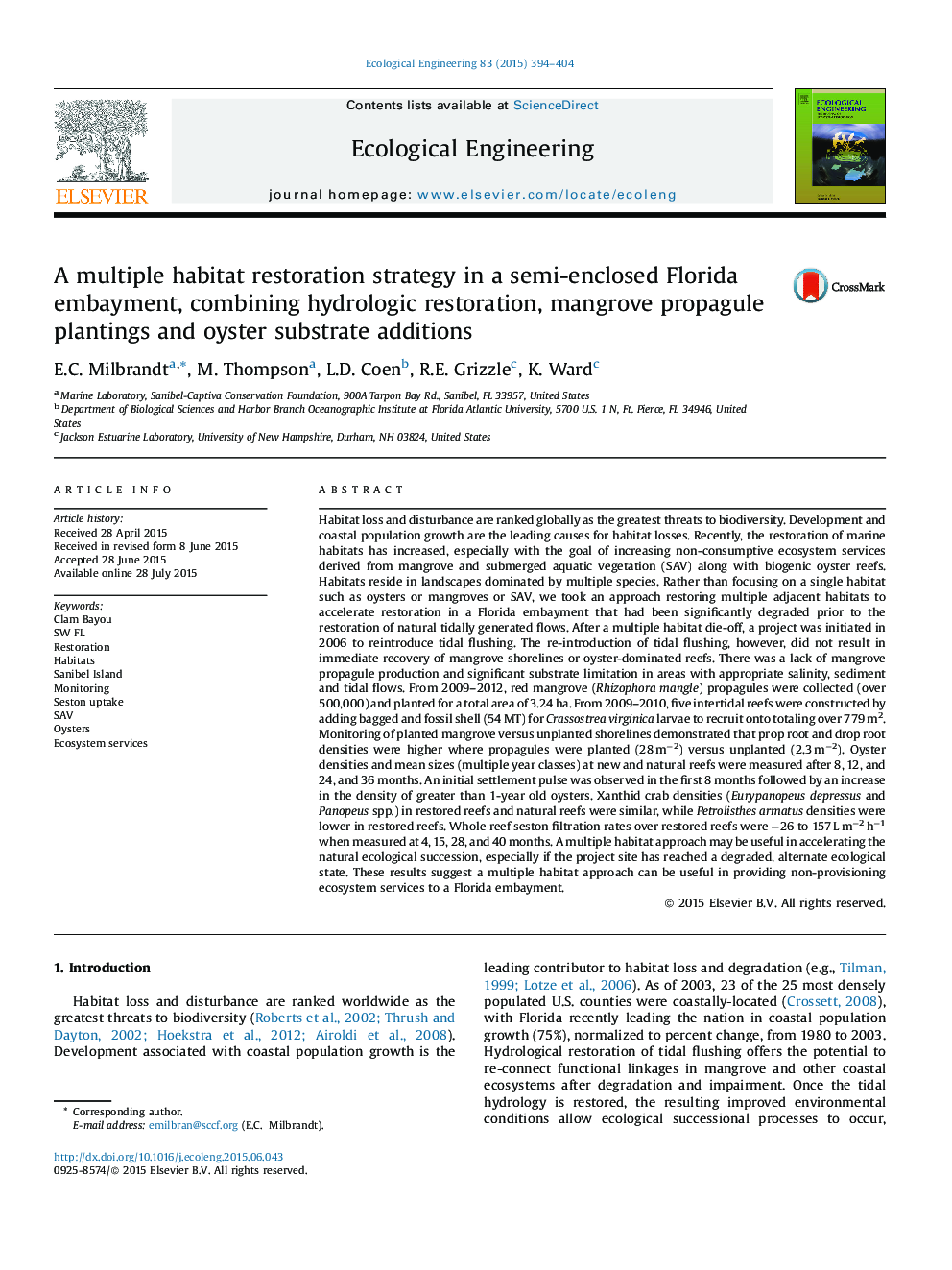| کد مقاله | کد نشریه | سال انتشار | مقاله انگلیسی | نسخه تمام متن |
|---|---|---|---|---|
| 4388889 | 1618016 | 2015 | 11 صفحه PDF | دانلود رایگان |
• Three years following the installation of a box culvert and reintroduction of tidal flow, subsequent recovery of propagule-limited mangrove shorelines and substrate-limited oyster reefs was delayed.
• Red mangrove (Rhizophora mangle) propagule collection and planting of the shoreline co-occurred with reef construction for settlement of the Eastern oyster (Crassostrea virginica).
• Over 500,000 propagules were planted in a 3.24 ha area consisting mostly of shoreline and 5 reefs for oyster settlement were built for a total of 779 m2.
• Increases in abundances of R. mangle and C. virginica were observed during post restoration monitoring.
• The potential for enhanced non-consumptive ecosystem services were demonstrated with greater prop root complexity in planted areas, whole reef seston uptake of chlorophyll a, and habitat provisioning.
Habitat loss and disturbance are ranked globally as the greatest threats to biodiversity. Development and coastal population growth are the leading causes for habitat losses. Recently, the restoration of marine habitats has increased, especially with the goal of increasing non-consumptive ecosystem services derived from mangrove and submerged aquatic vegetation (SAV) along with biogenic oyster reefs. Habitats reside in landscapes dominated by multiple species. Rather than focusing on a single habitat such as oysters or mangroves or SAV, we took an approach restoring multiple adjacent habitats to accelerate restoration in a Florida embayment that had been significantly degraded prior to the restoration of natural tidally generated flows. After a multiple habitat die-off, a project was initiated in 2006 to reintroduce tidal flushing. The re-introduction of tidal flushing, however, did not result in immediate recovery of mangrove shorelines or oyster-dominated reefs. There was a lack of mangrove propagule production and significant substrate limitation in areas with appropriate salinity, sediment and tidal flows. From 2009–2012, red mangrove (Rhizophora mangle) propagules were collected (over 500,000) and planted for a total area of 3.24 ha. From 2009–2010, five intertidal reefs were constructed by adding bagged and fossil shell (54 MT) for Crassostrea virginica larvae to recruit onto totaling over 779 m2. Monitoring of planted mangrove versus unplanted shorelines demonstrated that prop root and drop root densities were higher where propagules were planted (28 m−2) versus unplanted (2.3 m−2). Oyster densities and mean sizes (multiple year classes) at new and natural reefs were measured after 8, 12, and 24, and 36 months. An initial settlement pulse was observed in the first 8 months followed by an increase in the density of greater than 1-year old oysters. Xanthid crab densities (Eurypanopeus depressus and Panopeus spp.) in restored reefs and natural reefs were similar, while Petrolisthes armatus densities were lower in restored reefs. Whole reef seston filtration rates over restored reefs were −26 to 157 L m−2 h−1 when measured at 4, 15, 28, and 40 months. A multiple habitat approach may be useful in accelerating the natural ecological succession, especially if the project site has reached a degraded, alternate ecological state. These results suggest a multiple habitat approach can be useful in providing non-provisioning ecosystem services to a Florida embayment.
Journal: Ecological Engineering - Volume 83, October 2015, Pages 394–404
